Medication
Local anesthetics
These agents stabilize the neuronal membrane and prevent the initiation and transmission of nerve impulses.
Dyclonine (Dyclone)
Oral local anesthetic that blocks impulses at peripheral nerve endings in skin and mucous membranes by changing permeability of cell membrane to certain ions. Used for temporary relief of pain associated with oral mucosa.
Adult
5-10 mL of 0.5% or 1% solution applied to oral mucosa (swab or swish and expectorate) tid/qid prn; not to exceed 200 mg or 40 mL of 0.5% solution or 20 mL of 1% solution
Pediatric
<2>2 years: 1 children's strength (1.2 mg) lozenge, dissolved slowly in mouth q2h prn
None reported
Documented hypersensitivity
Pregnancy
C - Fetal risk revealed in studies in animals but not established or not studied in humans; may use if benefits outweigh risk to fetus
Precautions
Hypotension; bradycardia; cardiac arrest; excitation; drowsiness; nervousness; dizziness; seizures; blurred vision; respiratory arrest; allergic reactions; slight stinging or irritation may occur upon application; reduce dose in children and patients who are debilitated, elderly, or acutely ill; patients who use topical anesthetics may experience impaired swallowing and increased risk of aspiration (avoid consumption of food for 60 min after oral application); numbness of tongue or buccal mucosa may increase risk of biting trauma
Lidocaine (Xylocaine)
Topical anesthetic for mucous membranes of mouth and pharynx that binds selectively to sodium channels, thus blocking entry of sodium ions into axon. Depolarization and progression of action potential is prevented.
Adult
1 tbsp (15 mL) or less undiluted solution, swish in mouth then expectorate; alternatively, apply up to 1 tbsp of solution to affected area with a cotton-tipped applicator; do not repeat more frequently than q3h; not to exceed 8 doses/d
Pediatric
<3>3 years with lean body mass and normal body development: Maximum dosage is calculated according to weight or age; based on weight, 1.5-2 mg/lb is recommended
Potential for increased toxicity with class I antiarrhythmic drugs (eg, tocainamide, mexiletine); effects are additive
Documented hypersensitivity
Pregnancy
B - Fetal risk not confirmed in studies in humans but has been shown in some studies in animals
Precautions
Reduce dose in children and patients who are debilitated, elderly, or acutely ill based on age, weight, and physical condition; patients who use topical anesthetics may experience impaired swallowing and increased risk of aspiration (avoid consumption of food for 60 min after oral application); numbness of tongue or buccal mucosa may increase risk of biting trauma
Analgesics
These agents ensure patient comfort, promote pulmonary toilet, and have sedating properties.
Acetaminophen (Tylenol)
Used to treat pain and fever. Has no anti-inflammatory effects. Inhibits synthesis of prostaglandins in CNS and peripherally blocks pain impulse generation. Causes antipyresis by inhibiting hypothalamic heat-regulating center.
Adult
325-650 mg (1-2 tab) q4-6h or 1000 mg tid/qid; not to exceed 4 g/d (4000 mg)
Pediatric
<12>12 years: Administer as in adults
Long-term increased ingestion of alcohol and high doses leads to liver toxicity; cholestyramine decreases plasma levels and may lower response; INH increases blood levels; hepatotoxicity has been reported; barbiturates may increase hepatotoxicity caused by large amounts of acetaminophen; phenytoin can increase the hepatotoxic potential of high doses; warfarin can lead to increased anticoagulation
Documented hypersensitivity; G-6-PD deficiency
Pregnancy
B - Fetal risk not confirmed in studies in humans but has been shown in some studies in animals
Precautions
May cause hepatic toxicity in extremely high doses; use with caution in patients with alcoholic cirrhosis; liver damage has been observed in patients taking 5-8 g/d over several wk or 3-4 g/d for 1 y
Nonsteroidal anti-inflammatory drugs
These agents have analgesic, anti-inflammatory, and antipyretic activities. Their mechanism of action is not known, but they may inhibit cyclo-oxygenase activity and prostaglandin synthesis. Other mechanisms may also exist, including inhibition of leukotriene synthesis, lysosomal enzyme release, lipoxygenase activity, neutrophil aggregation, and various cell membrane functions.
Ibuprofen (Motrin, Advil)
Used in management of dental pain and swelling. For inflammatory conditions, mild to moderate pain, fever, dysmenorrhea, and acute migraine headaches. Inhibits prostaglandin synthesis by blocking action of cyclo-oxygenase.
Adult
400-800 mg/dose PO tid/qid; not to exceed 3.2 g/d
Pediatric
4-10 mg/kg/dose PO q6-8h
Decreases platelet aggregation, thus increases anticoagulant action of warfarin; may lower prostaglandin-induced renal clearance of lithium, with resultant elevated levels of lithium in plasma and potential lithium toxicity; may raise levels of methotrexate (MTX), with potential development of MTX toxicity; aspirin can lower serum levels; raloxifene (Evista) can interact with other highly protein-bound drugs, including ibuprofen; raloxifene can displace ibuprofen and vice versa, resulting in increased levels of either drug
Documented hypersensitivity; unsafe if administered during third trimester
Pregnancy
B - Fetal risk not confirmed in studies in humans but has been shown in some studies in animals
Precautions
Use with caution in patients with CHF, decreased renal or hepatic function, and GI disease; use with caution in patients taking anticoagulants; confusion, agitation, and hallucination possible with high doses
Antihistamines
Antihistamines are type 1 histamine receptor blockers that act to block the action of histamine after its release from mast cells and basophils. They are most effective when used prophylactically. The 2 classes of antihistamines are sedating and nonsedating. Typically, the sedating antihistamines are stronger and have more adverse anticholinergic effects.
Diphenhydramine (Benadryl, Benylin)
Competes with histamine for H1 receptors on effector cells of the GI tract, blood vessels, and respiratory tract, thereby leading to symptomatic relief of allergic symptoms caused by the action of histamine. Can induce local anesthetic effects through infiltration of mucous membranes.
Adult
12.5 mg with 5 mL elix, swish with 1 tbsp (15 mL) of solution for 1-2 min and expectorate; may repeat several times per day prn; a 50/50 mixture of the 12.5 mg/5 mL solution mixed with kaolin susp, sucralfate susp, Kaopectate, or Maalox can also be used; swish 1 tbsp (15 mL) in mouth and expectorate; repeat up to 4 times/d
Pediatric
A maximum of 5 mg/kg/d; swish with 1 tbsp (15 mL) of solution for 1-2 min and expectorate; may repeat several times per day prn
Do not administer with CNS depressants because diphenhydramine may worsen CNS and/or respiratory depression; may interact with MAOIs and lead to increased anticholinergic effects; do not administer elix to patients taking drugs that can cause disulfiram reactions (eg, metronidazole, chlorpropamide) because of high alcohol content
Documented hypersensitivity; do not use during acute asthma attacks
Pregnancy
C - Fetal risk revealed in studies in animals but not established or not studied in humans; may use if benefits outweigh risk to fetus
Precautions
Use with caution in patients with narrow-angle glaucoma, peptic ulcers, urinary tract obstruction, and hyperthyroidism; elix has high sedative and anticholinergic effects and may not be appropriate for prolonged use in elderly patients
Antivirals
Nucleoside analogs are initially phosphorylated by viral thymidine kinase to eventually form a nucleoside triphosphate. Acyclovir triphosphate interferes with HSV DNA polymerase and inhibits viral DNA replication. The triphosphate can be incorporated into growing chains of DNA by viral DNA polymerase, resulting in termination of the DNA chain. Acyclovir is preferentially taken up and selectively converted to the active triphosphate form by HSV-infected cells. It is much less toxic to normal uninfected cells. In herpes zoster, acyclovir may decrease the prevalence of postherpetic neuralgia. These agents may also relieve and decrease the duration of symptoms.46,47,48,49,50
Acyclovir, oral (Zovirax)
Cap, oral susp, and tab dosages are bioequivalent. In patients who are otherwise healthy and immunocompetent, use for moderate-to-severe primary or recurrent HSV (HHV-1, HHV-2) infections, moderate-to-severe chickenpox, or acute herpes zoster. In patients who are immunocompromised, use for primary or recurrent mucocutaneous HSV (HHV-1, HHV-2) infections, chickenpox, herpes zoster, oral hairy leukoplakia, or CMV oral ulcerations. Poorly absorbed from GI tract, 10-20% bioavailability. Oral absorption not significantly affected by food. Widely distributed into tissues and body fluids. Subject to renal elimination by both glomerular filtration and tubular secretion. Half-life in adults with normal renal function is 2.5-3.3 h. Renal function impairment significantly increases half-life.
Adult
Primary HSV: 200 mg q4h PO 5 times/d for 10 d; alternatively, 500 mg tid PO for 7-10 d (In patients who are immunocompromised, duration of treatment may need to be prolonged until lesions have reepithelialized; alternatively, increase oral dose to 400 mg q4h PO 5 times/d for 10 d)
Recurrent HSV (intermittent therapy; <6>>6 episodes/y): 400 mg bid PO or 200 mg PO 3-5 times/d for up to 12 mo
Prophylaxis against recurrent HSV: 400 mg q12h PO
Herpes zoster: 800 mg 5 times/d PO for 7-10 d; for severe infection, 5 mg (base) per kg body weight q8h IV for 5-7 d (administer at constant rate over at least 1 h); patients with acute or chronic renal impairment may require dose reduction (200 mg q12h PO when CrCl 0-10 mL/min or 0-0.17 mL/s
Pediatric
<2>2 years: Data limited; 3000 mg/m2/d or 80 mg/kg suggested (no unusual toxicity or pediatric-specific problems); half-life of IV form in children >1 y similar to that in adults with normal renal function
Nephrotoxic medications (eg, aminoglycosides, carbamazepine, ciprofloxacin, cisplatin, cyclosporin, lithium, meperidine, intrathecal MTX, metronidazole, parenteral penicillins, tiopronin); concurrent use with oral or parenteral acyclovir may increase potential for nephrotoxicity, especially in the presence of renal function impairment; probenecid may decrease renal tubular of acyclovir, resulting in increased serum and CSF levels, prolonged elimination half-life in serum and CSF, and potentially increased toxicity
Documented hypersensitivity to acyclovir, ganciclovir, or valacyclovir; caution in renal function impairment or dehydration because risk of adverse effects is increased; caution in elderly patients with neurologic abnormalities
Pregnancy
C - Fetal risk revealed in studies in animals but not established or not studied in humans; may use if benefits outweigh risk to fetus
Precautions
Adverse effects may include malaise, GI disturbances (nausea, vomiting, diarrhea, abdominal pain), headache, lightheadedness, insomnia, somnolence, paraesthesia, acute renal failure, encephalopathic changes, hematologic abnormalities (anemia, leukocytosis, neutropenia or neutrophilia, thrombocytopenia or thrombocytosis), hematuria, allergy, anaphylaxis, urticaria, DIC, fever, hypotension, leukopenia, lymphadenopathy, peripheral edema, psychological disturbances (confusion, delirium, hallucinations, mental obtundation, psychosis), seizures, skin reactions (erythema multiforme, pruritus, rash, Stevens-Johnson syndrome, toxic epidermal necrolysis), and visual abnormalities
Distributed into breast milk in concentrations from 0.5-4 times the corresponding plasma concentration, which would potentially expose a nursing infant to a dose as high as 0.3 mg/kg/d; however, toxicity has not been observed
Half-life increased in patients with renal function impairment; in dialysis, adjust dosage according to patient's CrCl
A single 6-h period of hemodialysis reduces plasma concentration by approximately 60%; patient may require additional dosage after each dialysis treatment; peritoneal dialysis does not substantially alter clearance
Adverse effects may be more pronounced in elderly patients, which is likely due to age-related decrease in renal function; elderly patients may require adjustment of dose or dosing interval
May alter BUN and LFT values
In missed dose, take as soon as possible but do not take if almost time for next dose; do not double dose
Distributed into breast milk in concentrations from 0.5-4 times the corresponding plasma concentration, which would potentially expose a nursing infant to a dose as high as 0.3 mg/kg/d; however, toxicity has not been observed
Half-life increased in patients with renal function impairment; in dialysis, adjust dosage according to patient's CrCl
A single 6-h period of hemodialysis reduces plasma concentration by approximately 60%; patient may require additional dosage after each dialysis treatment; peritoneal dialysis does not substantially alter clearance
Adverse effects may be more pronounced in elderly patients, which are likely due to age-related decrease in renal function; elderly patients may require adjustment of dose or dosing interval
May alter BUN and LFT values
In missed dose, take as soon as possible but do not take if almost time for next dose; do not double dose
Acyclovir, topical 5% (Zovirax)
Treatment of initial and recurrent non–life-threatening mucocutaneous HSV infections in nonimmunocompromised patients. Used as adjunctive therapy to improve localized herpes zoster in immunosuppressed patients being treated systemically with other treatment regimens for herpes zoster. Resistance has been reported with prolonged treatment in immunocompromised patients. Resistance does not appear to be significant in immunocompetent patients. Minimal systemic absorption following topical administration. Patients with impaired renal function may have elevated serum levels.
Adult
Apply to affected area q3-4h, for a total of 6 times/d, for 7 d; apply a sufficient quantity to adequately cover all lesions
Pediatric
>2 years: Safety and efficacy not established; 3000 mg/m2/d or 80 mg/kg suggested (no unusual toxicity or pediatric-specific problems)
None reported
Documented hypersensitivity to acyclovir, ganciclovir, or valacyclovir; caution in renal function impairment or dehydration because risk of adverse effects is increased; caution in elderly patients with neurologic abnormalities
Pregnancy
C - Fetal risk revealed in studies in animals but not established or not studied in humans; may use if benefits outweigh risk to fetus
Precautions
Adverse effects may include mild pain with transient burning or stinging (10-30%) and itching (1-10%%); for breastfeeding, small amount absorbed across disease tissues and because total daily topical dose is small, unlikely that significant amount is distributed in breast milk; no geriatric-specific problems reported, but no appropriate studies have not been performed; may lead to skin sensitization, resulting in hypersensitivity reactions with subsequent topical or systemic use; avoid contact with eyes; in missed dose, apply as soon as possible and do not apply if almost time for next dose
Valacyclovir (Valtrex)
Prodrug that is nearly completely converted to acyclovir and L-valine. Phosphorylated by thymidine kinase to acyclovir monophosphate, which is then converted to diaphorase and triphosphate. Acyclovir is selectively converted to active triphosphate form by cells infected with herpes viruses. Used for treatment of acute herpes zoster in patients who are healthy and immunocompetent. Therapy is most effective when started within 48 h after onset of symptoms. Minimizes pain and duration of postherpetic neuralgia more effectively than acyclovir.
Oral form is rapidly absorbed and converted to acyclovir by first-pass intestinal and hepatic metabolism. Food not found to alter bioavailability. Half-life <30>
Adult
Primary HSV: 1000 mg bid PO for 7-10 d
Recurrent episodes: 500 mg bid PO for 5 d
Long-term suppression: 1000 mg/d PO
Pediatric
Not established
Cimetidine and probenecid decrease rate but not to extent of conversion of valacyclovir to acyclovir; both drugs reduce renal clearance of acyclovir, resulting in increased plasma concentration
Documented hypersensitivity to acyclovir, ganciclovir, or valacyclovir; caution in renal function impairment or dehydration because risk of adverse effects is increased; caution in elderly patients with neurologic abnormalities
Pregnancy
B - Fetal risk not confirmed in studies in humans but has been shown in some studies in animals
Precautions
Adverse effects may include acute hypersensitivity reactions and anaphylaxis, dysmenorrhea, aplastic anemia, hemolytic anemia, hepatitis with LFT abnormalities, renal insufficiency, thrombocytopenia, facial edema, skin reactions (erythema multiforme, photosensitivity, rash), tachycardia, GI disturbances (nausea, vomiting, diarrhea, abdominal pain, constipation), hypertension, microangiopathic, CNS disturbance (headache, somnolence, agitation, confusion, hallucinations, dizziness), and fatigue
Increased risk of adverse effects in patients with renal or hepatic disease, advanced HIV infection, bone marrow transplant, or kidney disease; kidney disease may increase blood levels; concurrent administration with potentially nephrotoxic agents may increase risk of renal dysfunction and/or reversible CNS manifestations; patients with a CrCl <50>
Famciclovir (Famvir)
Prodrug of penciclovir. Penciclovir is further metabolized by viral thymidine kinase to penciclovir triphosphate. Active drug inhibits viral DNA synthesis, thereby inhibiting viral replication. Used for treatment of acute herpes zoster in patients who are healthy and immunocompetent or immunocompromised. Has been found to decrease duration of postherpetic neuralgia compared with placebo (55-62 d vs 128 d). Found to be equivalent to acyclovir in decreasing duration of acute pain. Therapy is most effective when initiated within 48 h of rash onset. Used for recurrent mucocutaneous HSV infections in HIV-infected patients.
Oral form rapidly absorbed in upper intestine and rapidly converted in intestinal wall to active drug, famciclovir. Oral absorption not significantly affected by food.
Oral form rapidly absorbed in upper intestine and rapidly converted in intestinal wall to active drug, famciclovir. Oral absorption not significantly affected by food.
Adult
Primary HSV: 500 mg q8h PO for 7 d
Long-term suppression: 250 mg q12h PO for up to 1 y
HSV, HIV-associated (treatment): 500 mg q12h PO for 7 d
Possible dose change for impaired renal function: CrCl 20-39 mL/min, 500 mg/d; CrCl <20>
Pediatric
Not established
Coadministration of probenecid or cimetidine may increase toxicity; coadministration increases bioavailability of digoxin
Documented hypersensitivity to penciclovir or famciclovir
Pregnancy
B - Fetal risk not confirmed in studies in humans but has been shown in some studies in animals
Precautions
Caution in renal failure or coadministration of nephrotoxic drugs
Penciclovir, topical (Denavir)
Taken up by infected cells. Metabolized by viral thymidine kinase to penciclovir triphosphate. Active drug inhibits viral DNA synthesis, thereby inhibiting viral replication. Treatment of initial and recurrent non–life-threatening mucocutaneous HSV infections in nonimmunocompromised patients. Has in vitro inhibitory activity against HSV-1 and HSV-2. Minimal systemic absorption following topical administration. Has not been detected in urine of male volunteers following daily topical application at doses 67 times higher than estimated clinical dose.
Adult
Apply to affected area q2h for 4 d; apply sufficient quantity to adequately cover all lesions
Pediatric
Not established
None reported
Documented hypersensitivity to penciclovir or famciclovir
Pregnancy
B - Fetal risk not confirmed in studies in humans but has been shown in some studies in animals
Precautions
Adverse effects may include hypoesthesia, taste perversion, and erythematous rash; with breastfeeding, small amount absorbed across disease tissues and because total daily topical dose is small, it is unlikely that significant amount is distributed in breast milk; adverse effects profile in elderly patients comparable to that in younger patients, but appropriate studies have not been performed; avoid contact with eyes; in missed dose, apply as soon as possible but do not apply if almost time for next dose
Multimedia
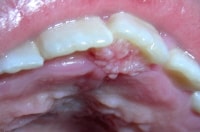 | Media file 10: This is a verruca vulgaris of the anterior maxillary gingiva in a healthy young male. He had recently resolved a wart on his finger. |
 | Media file 11: Papillomas, which are of questionable viral origin, are frequent findings in the oral cavity, especially on the lateral/ventral tongue and soft palate. |
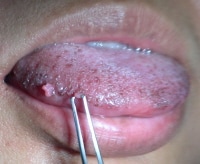 | Media file 12: These small papillomas on the lateral tongue of a young woman showed histologic evidence of HPV in the form of extensive koilocytosis. |
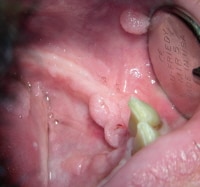 | Media file 13: Multiple condylomas are seen in this HIV+ male with a CD4 count of 11, and recent neurosyphilis. |
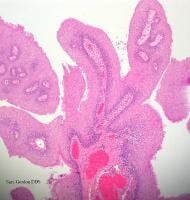 | Media file 18: Human papillomavirus (HPV). Verrucae and papillomas appear as frondlike epithelial proliferations. Verrucae tend to be more keratinized with sharper projections than papillomas. |
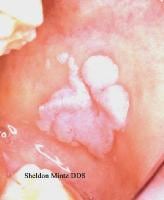 | Media file 22: Human papillomavirus (HPV). Heck disease in the buccal mucosa of a 7-year-old boy. Courtesy of Sheldon Mintz, DDS. |
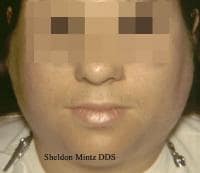 | Media file 23: This patient with mumps has marked bilateral swelling of the salivary glands. Courtesy of Sheldon Mintz, DDS. |
 | Media file 24: A 21-year-old woman with infectious mononucleosis presents with a petechial lesion on her palate. |
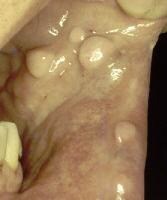 | Media file 25: Lesions on the buccal mucosa caused by human papillomavirus. |
Keywords
viral infections of the mouth, viral mouth infections, human herpesvirus, HHV, herpesvirus infections, human papillomavirus, HPV, coxsackievirus, mumps, measles, rubeola, rubella, mouth infections, viral mouth infections, oral infections, oral herpes, oral rubella, oral rubeola, oral measles, oral mumps
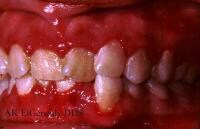
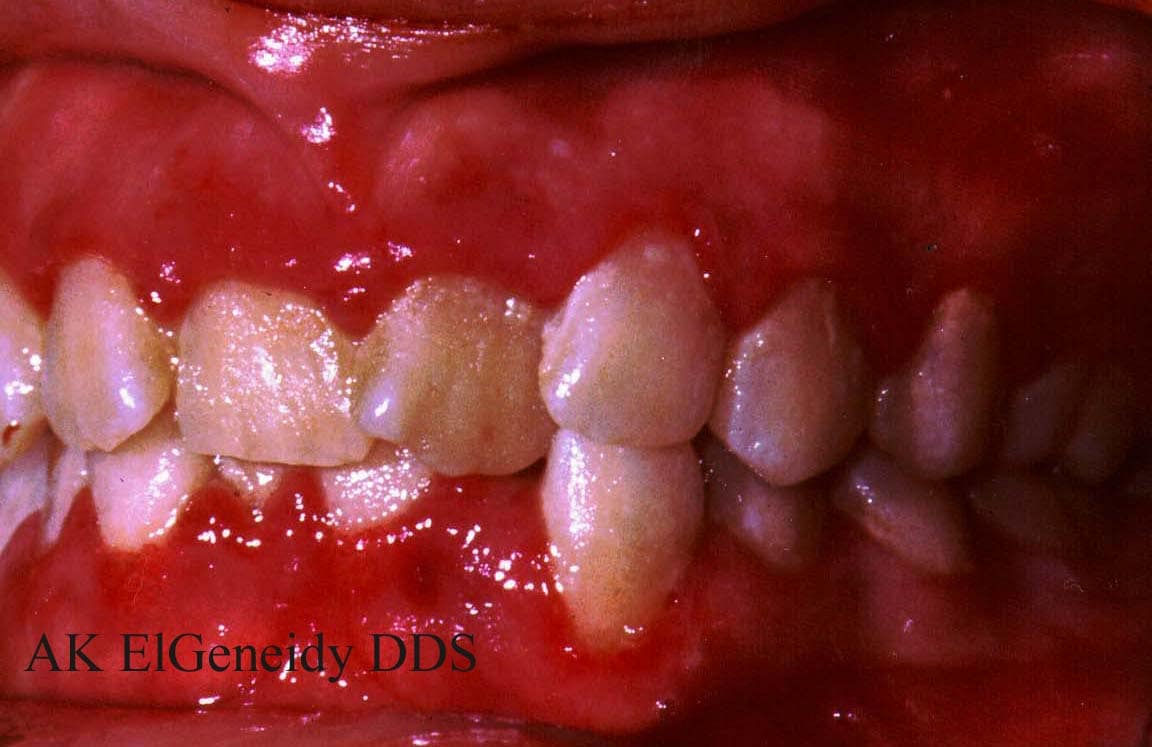
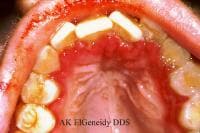
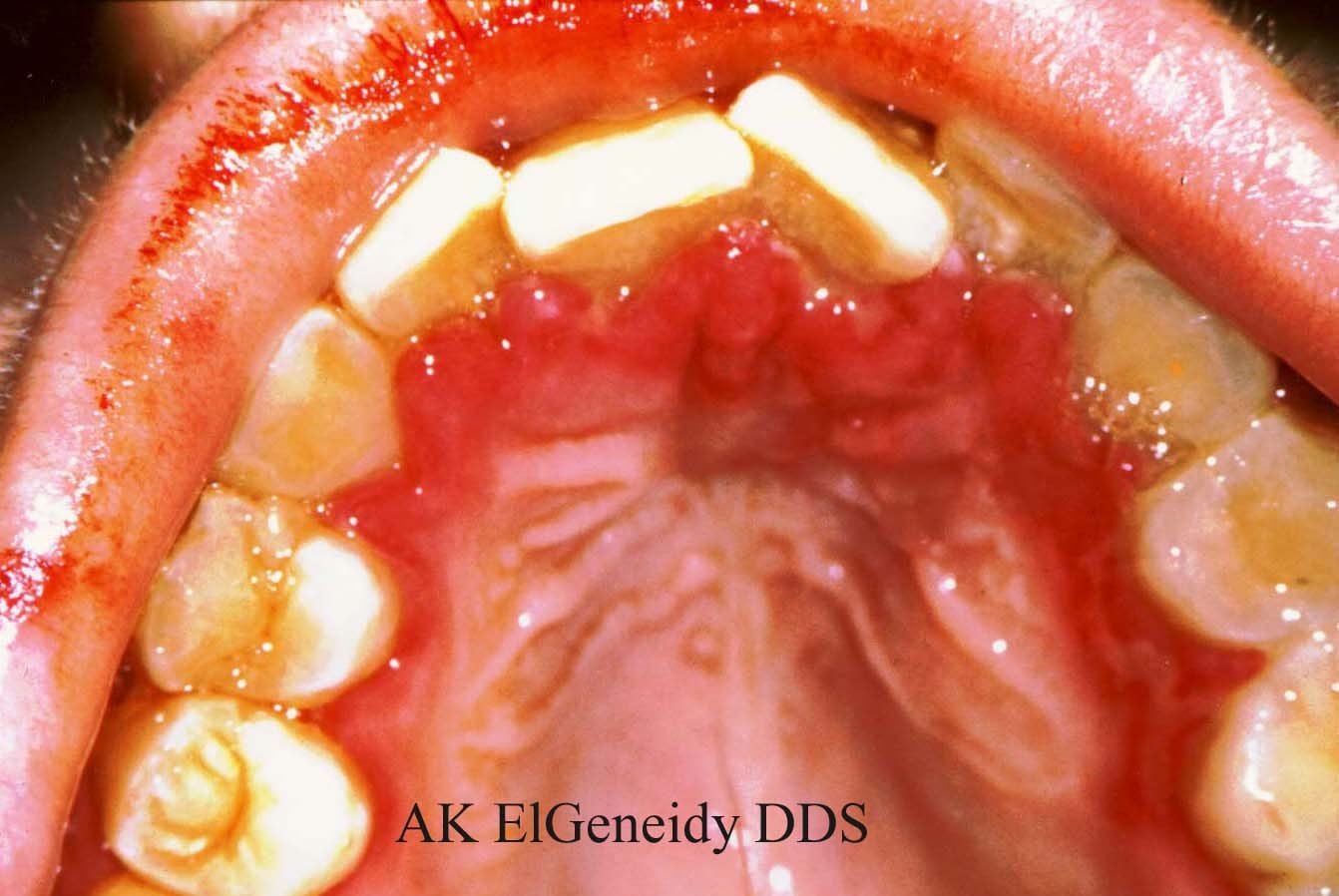
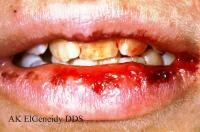

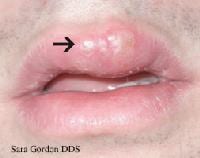
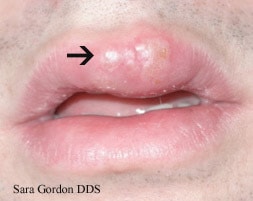
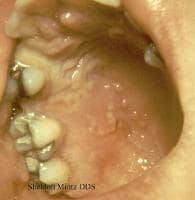
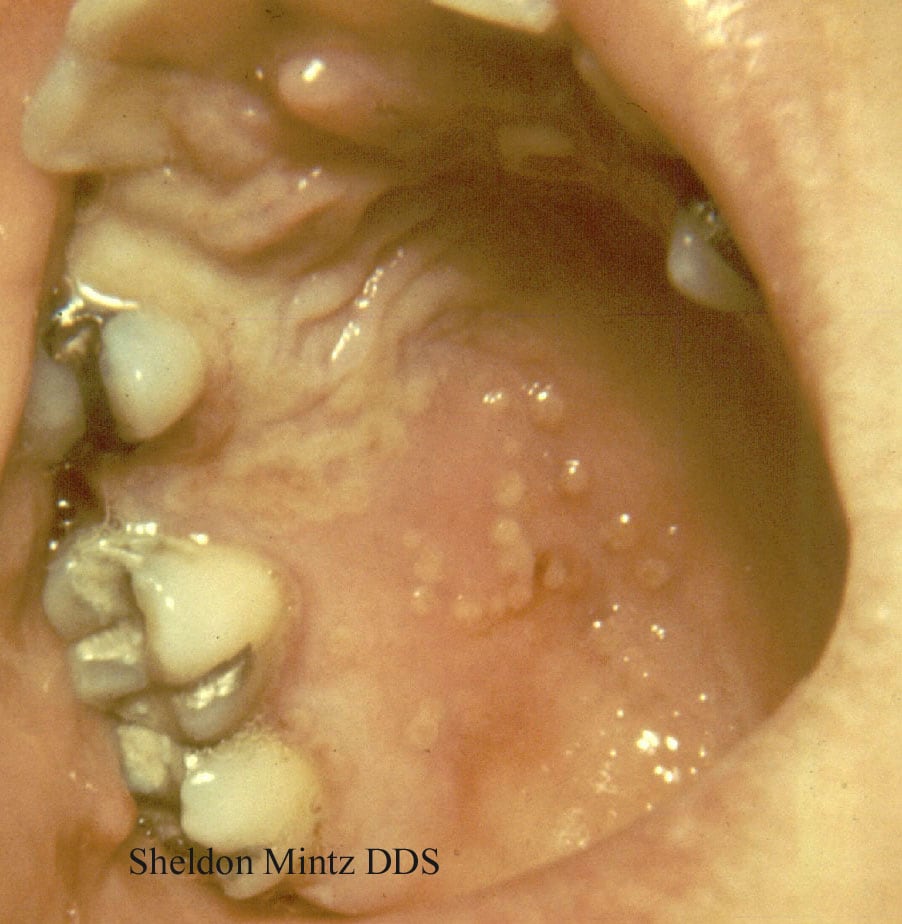
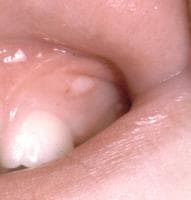
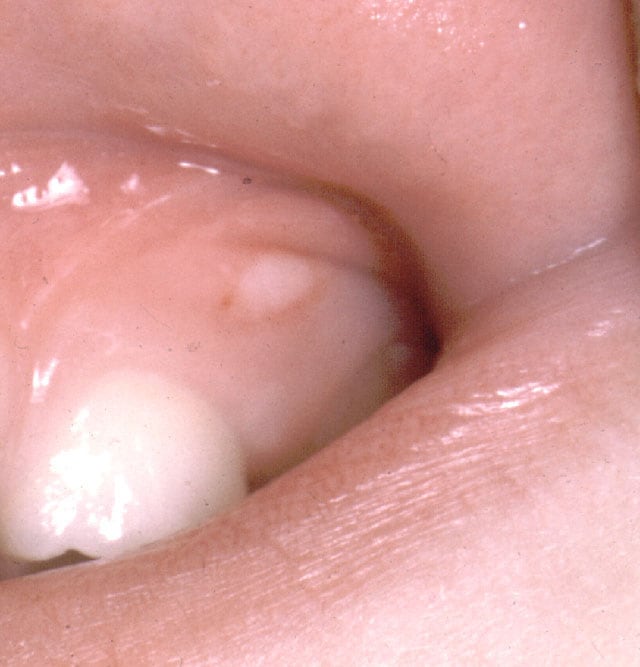
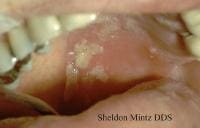

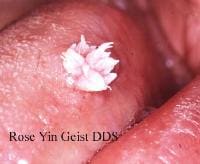
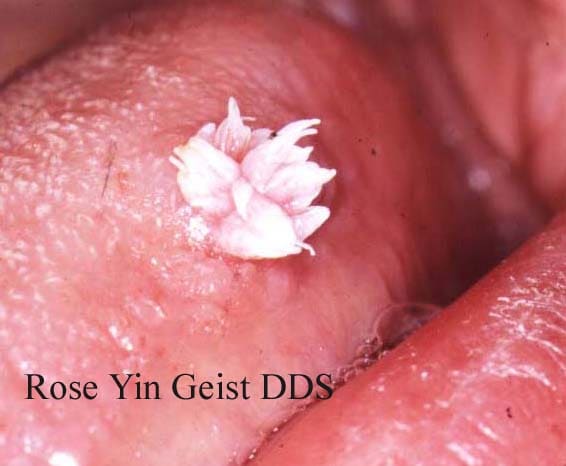
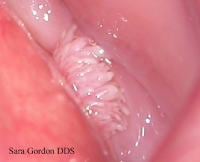
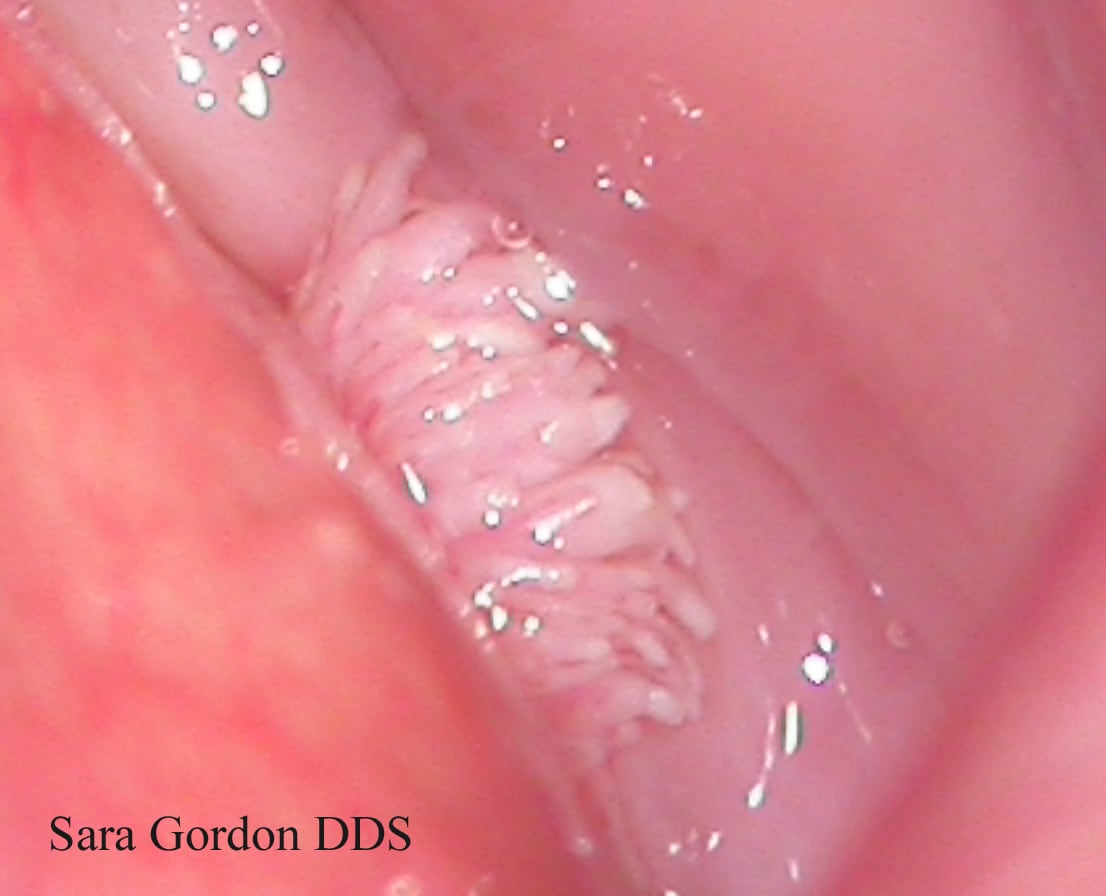
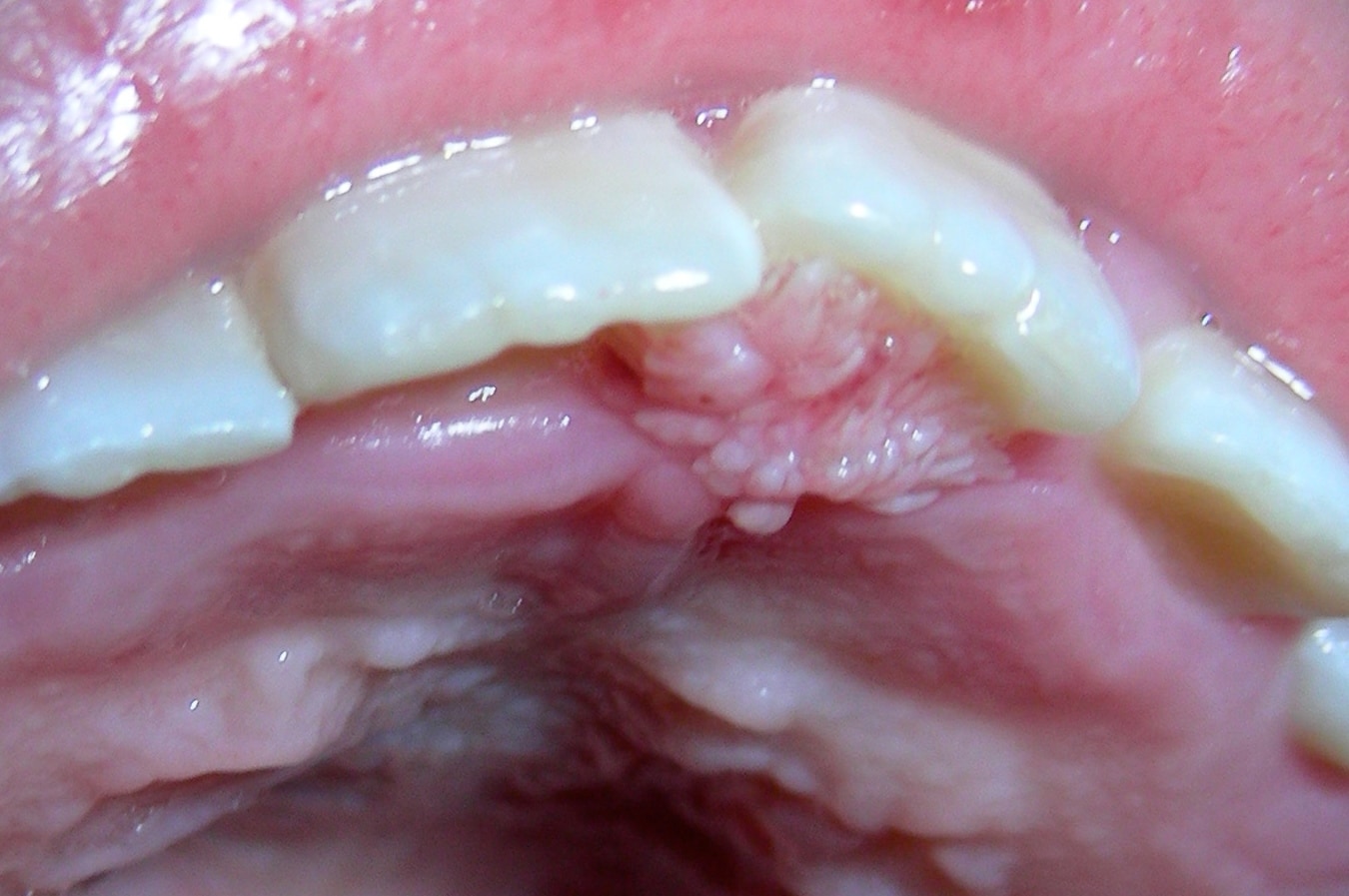
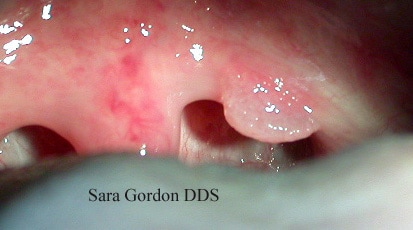
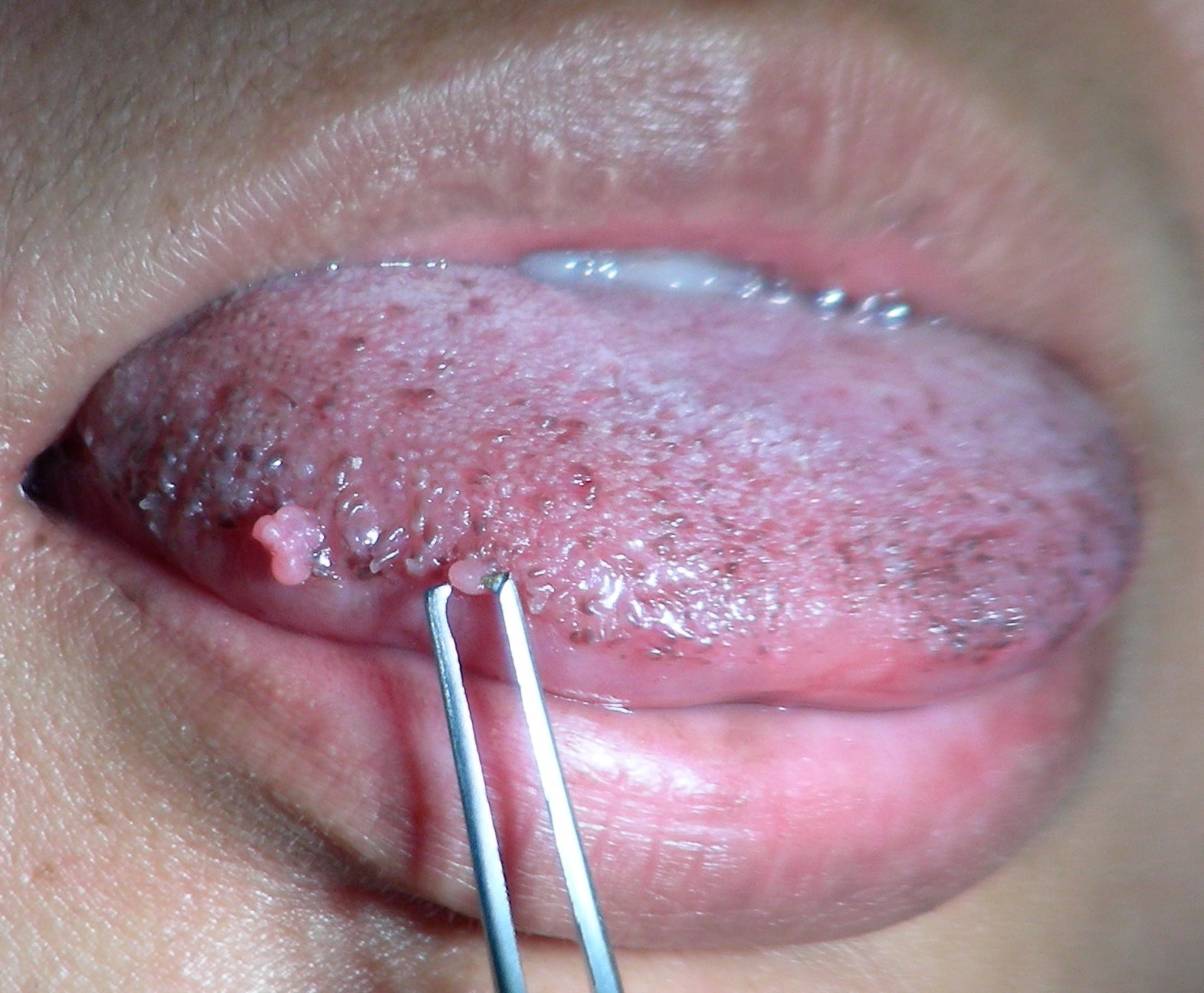
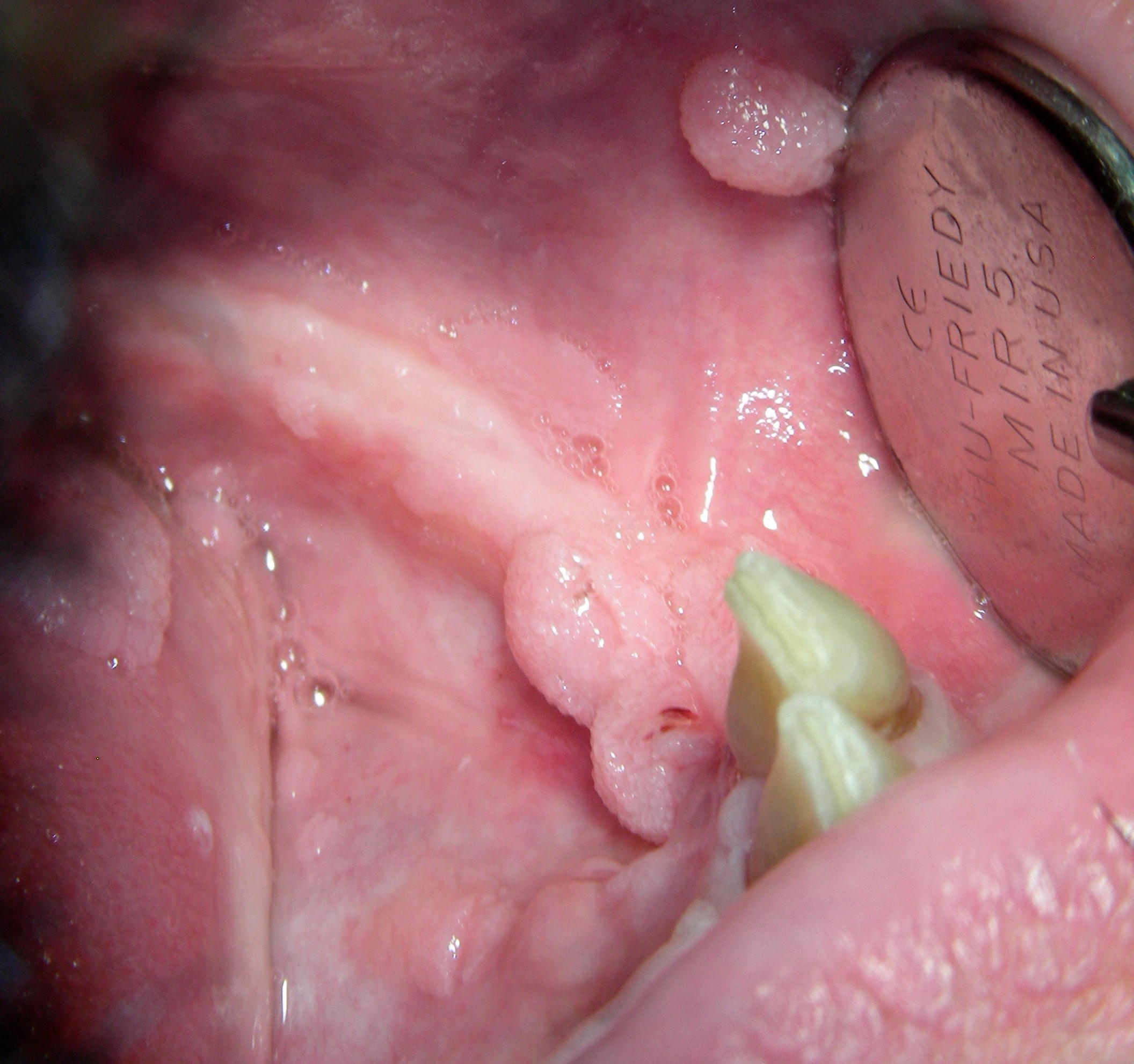
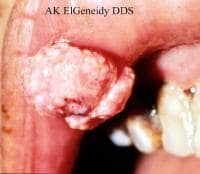
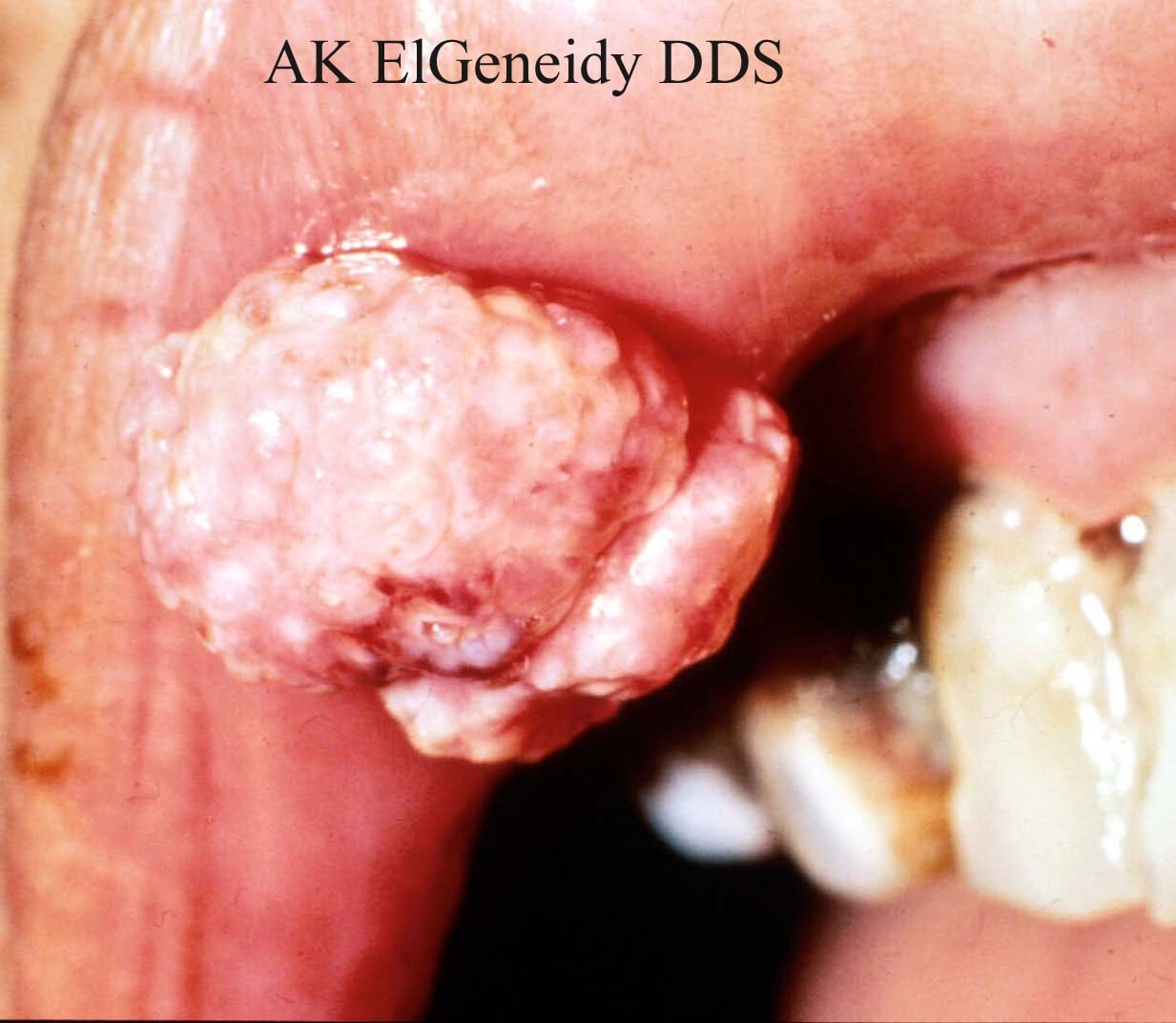
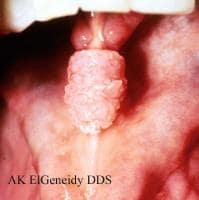
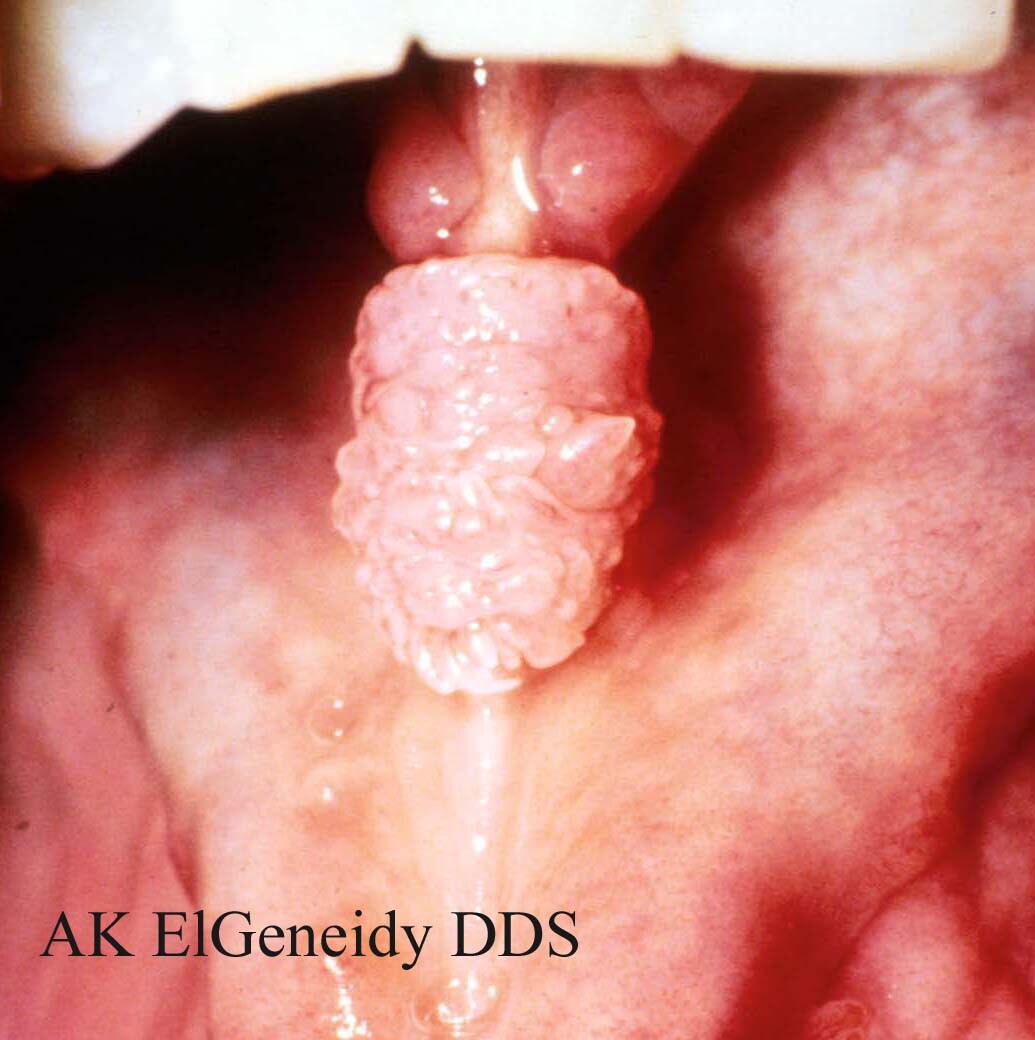
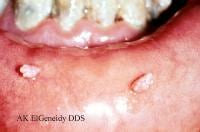
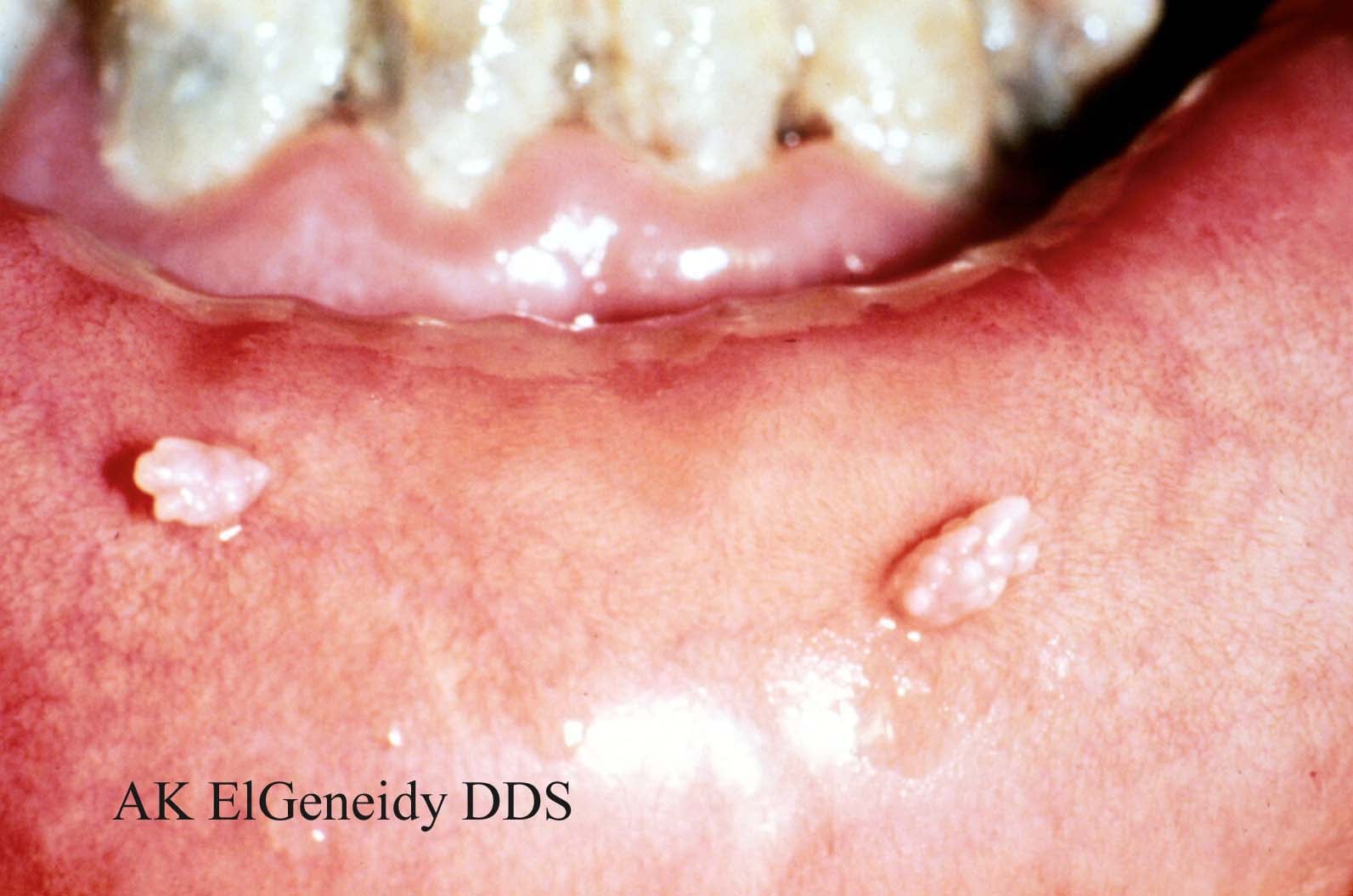

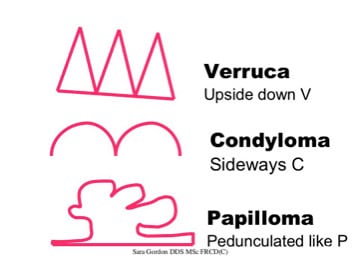
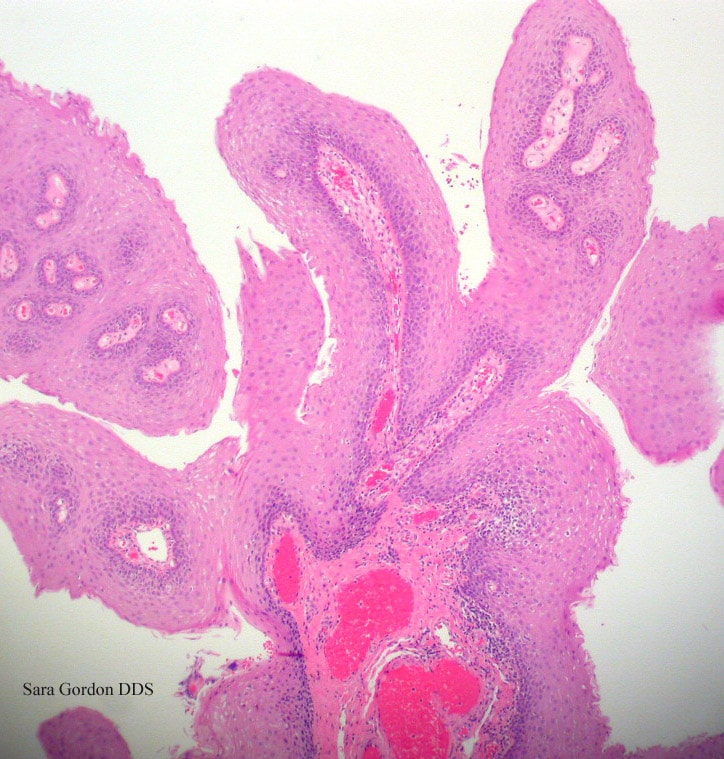
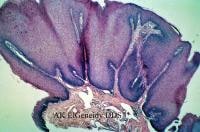
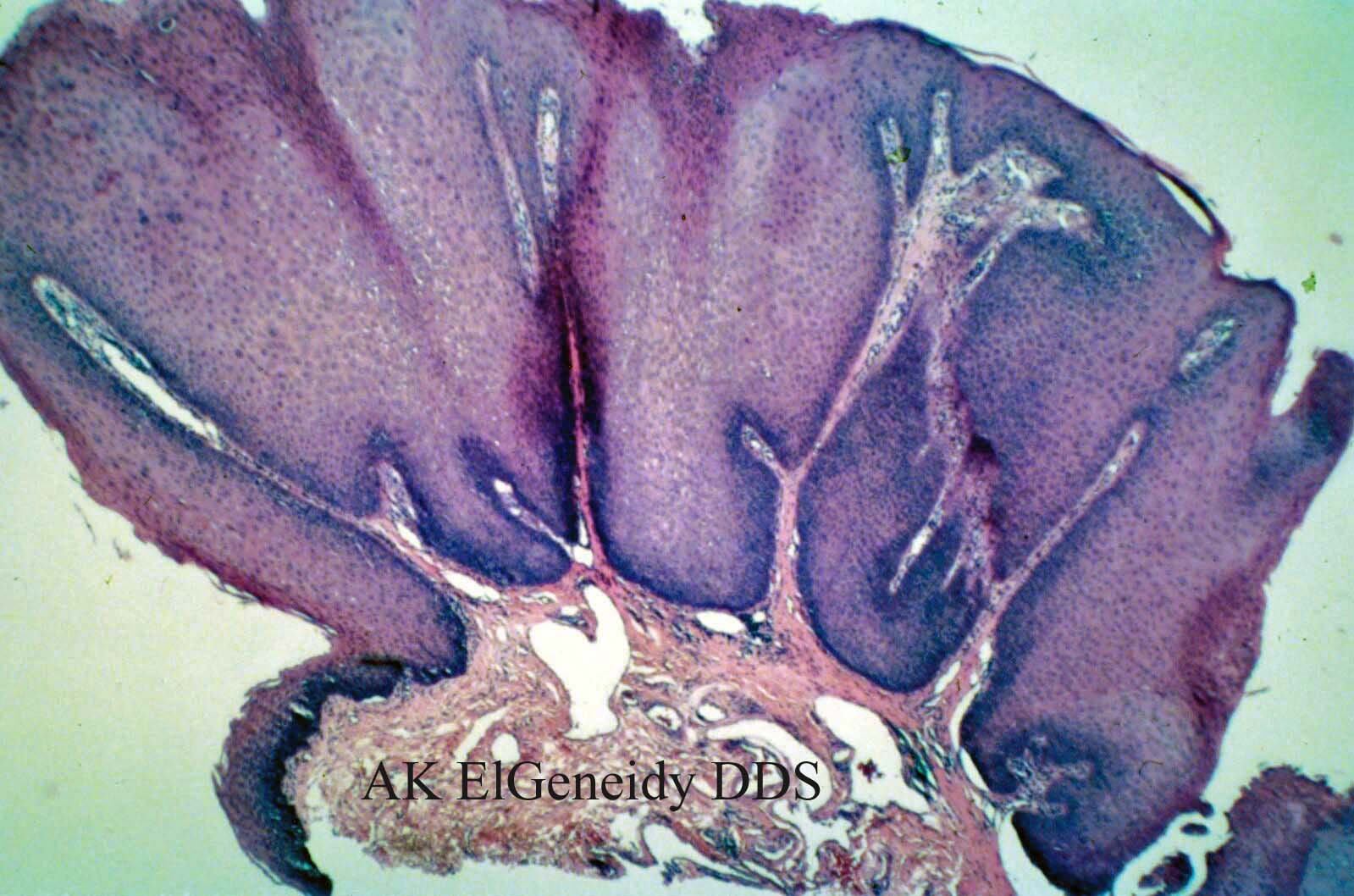
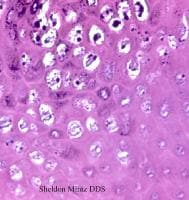
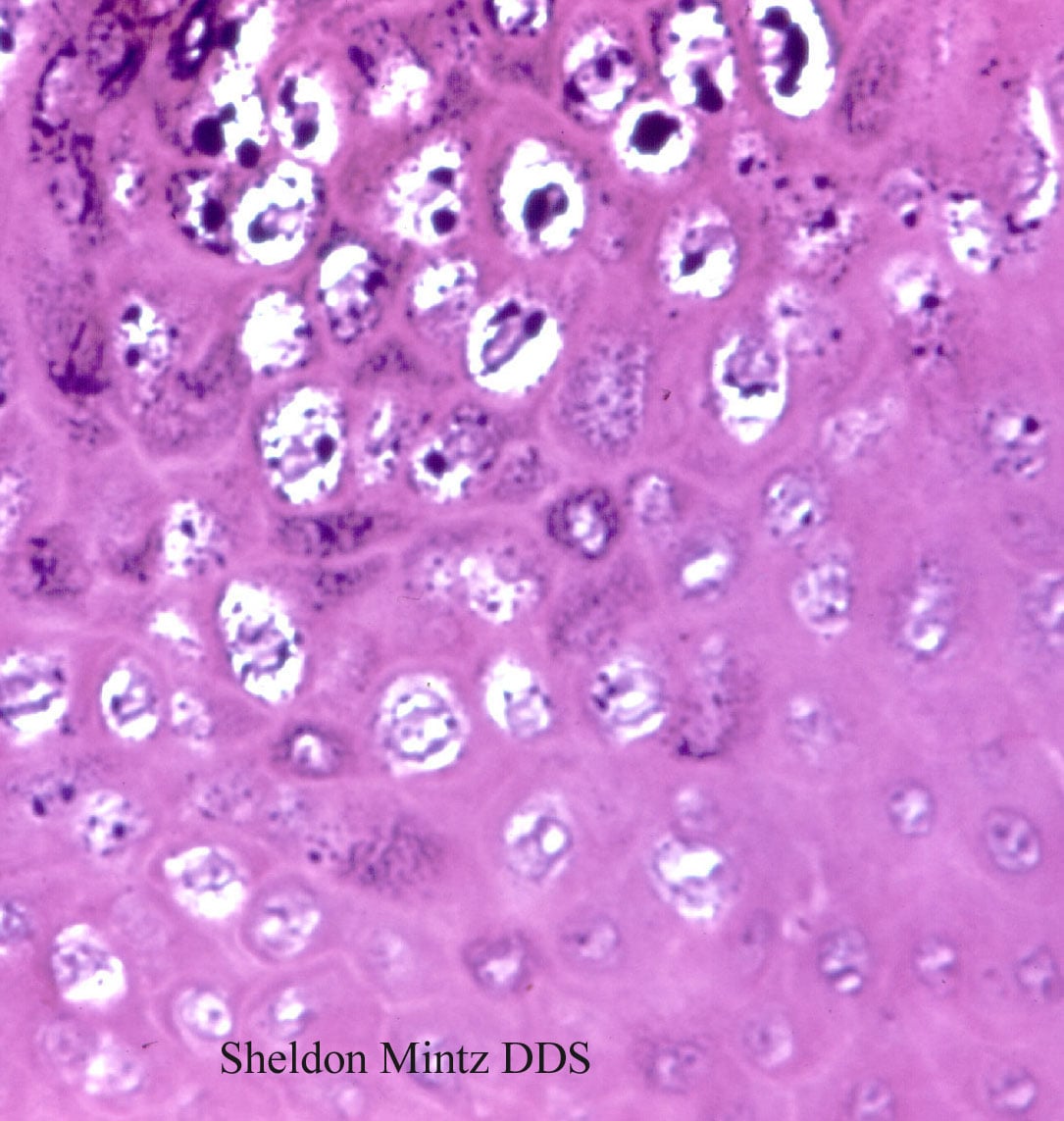
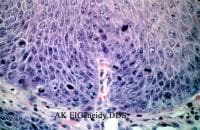
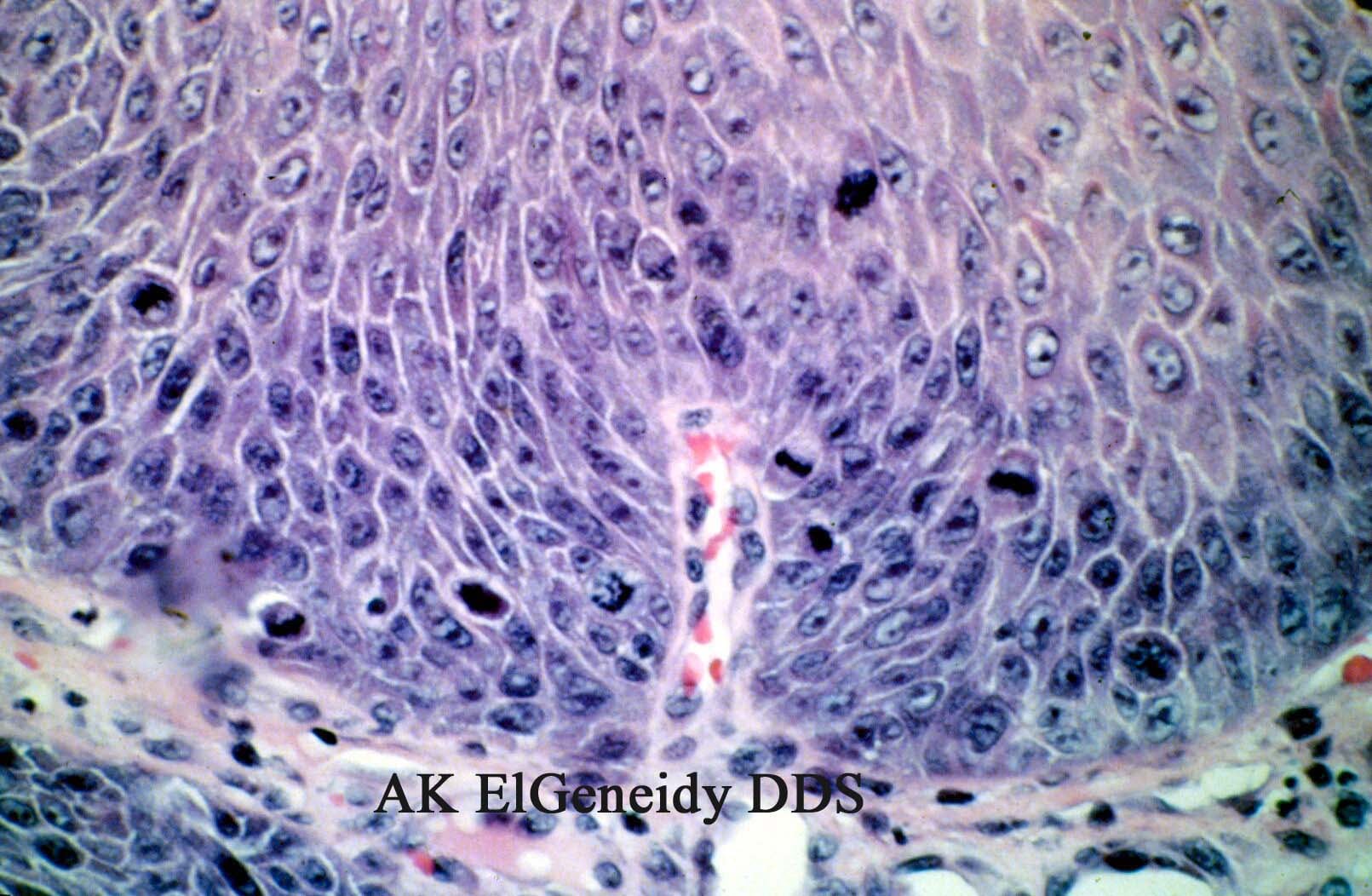



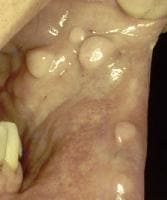

Dr Itua cure my HIV, I have been a ARV Consumption for 10 years. i have been in pains until i came across Dr Itua on blogs site.I emailed him about my details of my HIV and my location i explained every thing to him and he told me that there is nothing to be scared of that he will cured me, he gave me guarantee,He ask me to pay for items fees so when i'm cured I will show gratitude I did and giving testimony of his healing herbs is what I'm going to do for the rest of you out there having HIV and other disease can see the good work of Dr Itua.I received his herbal medicine through EMS Courier service who delivered to my post office within 5 working days.Dr Itua is an honest man and I appreciate him for his good work.My GrandMa called him to appreciate him and rest of my friends did too,Is a joy to me that I'm free of taking Pills and having that fat belle is a nightmare.you will understand what i'm talking about if you have same problem I was having then not now though.I'm free and healthy Big Thanks To Dr Itua Herbal Center.I have his calendar too that he recently sent me,He Cure all kind disease Like,Cancer,Herpes,Hiv,Hepatitis B,Fibroid,Diabetes,Dercum,Copd ,and also Bring back Ex Lover Back..Here his Contact .drituaherbalcenter@gmail.com Or Whats_app Number +2348149277967
Trả lờiXóaI was diagnose with genital warts since 2012 i have be taking lot treatment and all i got is outbreak. in 2015 I gave up the treatment because I can't continues wasting time and money on treatment at the end it will not cure me. about 6 weeks ago i did natural research online I had So many people talking good about natural remedy, after the research i was recommended to Dr onokun, And I wrote to him through his email and told him my problem after some conversations with him he gave me natural treatment after 1 week Dr onokun treated me i got cured permanently. and i went to see my doc he confirmed that the diseases has gone out from my body. every patients should know there is 100% natural hpv cure. contact Dr onokun his email address: dronokunherbalcure@gmail.com
Trả lờiXóa